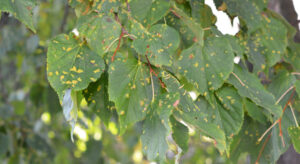
Understanding & Combating Anthracnose: A Guide for Maryland, Virginia, & DC Suburban Homeowners
As arborists committed to the health and well-being of the green giants in our community, we find it crucial to address a prevalent concern in the Maryland, Virginia, and DC suburbs—anthracnose. This fungal disease has become increasingly troublesome due to the abundant rainfall and high humidity in our region. In this blog, we’ll delve into what anthracnose is, how it affects our beloved trees, and most importantly, how homeowners can protect their leafy companions.
What is Anthracnose?
Anthracnose is a fungal disease caused by various species of fungi belonging to the genus Colletotrichum or Gloeosporium. It primarily targets deciduous trees, including popular species like maples, oaks, and sycamores. The wet and humid conditions in our area create an ideal environment for anthracnose to thrive, making it a recurring challenge for local homeowners.
Identifying Anthracnose:
Recognizing anthracnose is crucial for early intervention. Look for the following symptoms:
- Blighted Leaves: Infected leaves exhibit irregular brown or black lesions, often starting at the leaf margins and progressing towards the center. The affected areas may appear sunken or water-soaked.
- Twig Dieback: Anthracnose can cause dieback of young twigs, leading to a sparse and unhealthy canopy.
- Premature Leaf Drop: Infected trees may shed their leaves prematurely, particularly in mid to late summer.
Impact of Rainfall and Humidity:
The climatic conditions in our region contribute significantly to the prevalence of anthracnose. The ample rainfall provides the moisture required for fungal spores to germinate, while the high humidity facilitates their rapid spread. These factors create a conducive environment for anthracnose outbreaks, posing a threat to the overall health of our trees.
Preventive Measures:
- Pruning Practices: Proper pruning enhances air circulation and sunlight penetration, reducing the humidity that fosters fungal growth.
- Fungicide Applications: Consider applying fungicides in the spring as a preventive measure, especially during wet seasons. Consult with a certified arborist to determine the most suitable fungicide for your specific trees.
- Proper Mulching: Maintaining a 2-4 inch layer of organic mulch around the base of your trees regulates soil moisture and minimizes spore splash-back onto leaves.
- Regular Inspections: Monitor your trees for early signs of anthracnose and promptly remove infected branches to prevent the spread of the disease.
As stewards of our local ecosystems, it’s essential for homeowners to be vigilant and proactive in protecting their trees from anthracnose. By implementing preventive measures, you can ensure the longevity and vitality of your trees. For personalized guidance and professional assistance, reach out to Titan Tree Care – we’re here to safeguard your landscape.
Remember, a healthy tree is a happy tree, and a happy tree contributes to a thriving and vibrant neighborhood!
Get a Quote
Looking for expert tree care? Fill out the form below and we’ll be in touch!
Looking for expert tree care?

